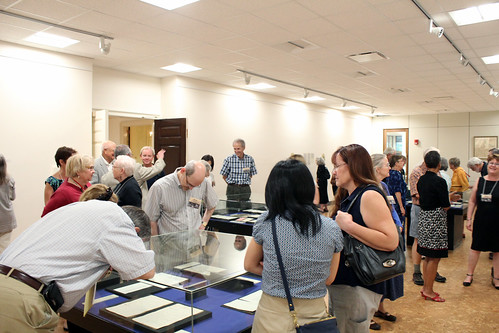Quantrill’s Raid on Lawrence: Stories of Loss Destruction and Survival
September 6th, 2013This week we present you with two labels from the Kenneth Spencer Research Library’s current exhibition: “Quantrill’s Raid on Lawrence: Stories of Loss, Destruction and Survival.” The exhibit, curated by Sheryl Willliams, Spencer’s Curator of Collections, commemorates the 150th anniversary of the infamous attack on Lawrence and draws on materials from the Kansas Collection‘s holdings to illuminate this significant chapter in Kansas history.
Title wall for the exhibition featuring a photograph of the 50th anniversary of survivors of Quantrill’s Raid.
August 21, 1913. Courtesy of KU Libraries. Click image to enlarge or travel to KU Libraries Flickr Stream.
Left: Visitors at the opening reception for “Quantrill’s Raid on Lawrence: Stories of Loss, Destruction and Survival”
Right: Curator of Collections Sheryl Williams speaks on Quantrill’s Raid.
Click image to enlarge or travel to KU Libraries Flickr Stream
The exhibition is open to the public in the Spencer Research Library’s gallery through the end of October and available online at http://exhibits.lib.ku.edu/exhibits/show/quantrill. We encourage readers to explore its moving stories of loss and resilience.
Hell Let Loose
On August 21, 1863 Quantrill and some four hundred men rode into Lawrence, on a dawn raid, catching the citizens by surprise, in spite of earlier rumors of possible attack. At the end of four hours at least 143 men and teen aged boys, most unarmed and unresisting, were known dead, many killed in front of their wives and children. Most of the business district was destroyed by fire, and many homes were plundered and burned. Lawrence was in ruins and its remaining citizens in shock and despair.
According to an account of the raid written shortly afterwards by Rev. Richard Cordley:
No one expected indiscriminate slaughter. When it was known that the town was in their possession, everybody expected that they would rob and burn the town, kill all military men they could find, and a few marked characters. But few expected a wholesale murder. … A gentlemen who was concealed where he could see the whole , said the scene presented was the most perfect realization of the slang phrase, “Hell let loose,” that could ever be imagined.
Destruction of Lawrence, an artist’s sketch from Harper’s Weekly. September 5, 1863. Call Number: RH PH 18:L:8.5. Online Exhibition item link.
The Horror And Sorrow
Excerpted from “William Clarke Quantrill and the Civil War Raid on Lawrence, Kansas, August 21, 1863, an Eyewitness Account,” Rev. Richard Cordley, edited by Richard B. Sheridan, 1999.
As the scene at their entrance was one of the wildest, the scene after their departure was one of the saddest that ever met mortal gaze. Massachusetts Street was one bed of embers. On this street seventy-five buildings, containing at least twice that number of places of business and offices, were destroyed. The dead lay all along the side-walk, many of them so burned that they could not be recognized, and could scarcely be taken up. Here and there among the embers could be seen the bones of those who had perished in the buildings and had been consumed. On two sides of another block lay seventeen bodies. Almost the first sight that met our gaze, was a father almost frantic, looking for the remains of his son among the embers of his office. The work of gathering and burying the dead soon began. From every quarter they were being brought in, until the floor of the Methodist Church, which was taken as a sort of a hospital, was covered with dead and wounded. In almost every house could be heard the wail of the widow and orphan. The work of burying was sad and wearying. Coffins could not be procured. Many carpenters were killed and most of the living had lost their tools. But they rallied nobly and worked day and night, making pine and walnut boxes, fastening them together with the burnt nails gathered from the ruins of the stores. It sounded rather harsh to the ear of the mourner, to have the lid nailed over the bodies of their loved ones; but it was the best that could be done. Thus the work went on for three days, til one hundred and twenty-two were deposited in the Cemetery, and many others in their own yard. Fifty-three were buried in one long grave. Early on the morning after the massacre, our attention was attracted by loud wailings. We went in the direction of the sound, and among the ashes of a building, sat a woman, holding in her hands the blackened skull of her husband, who was shot and burned at that place.
Left: Reverend Richard Cordley, no date. Call Number: RH PH 18:K:205(f). Online exhibition item link.
Right: William Elsey Connelley’s map showing the route followed in pursuing Quantrill after the Raid, no date. Call Number: RH Map P7. Online exhibition item link.
Sheryl Williams
Curator of Collections and Kansas Collection Librarian







![Photograph of Specimen Mountain Party, No. 3, August 19, 1889 [1891?].](https://blogs.lib.ku.edu/spencer/wp-content/uploads/2013/08/RG_17_40_1889_Prints_34-1024x679.jpg)
![Photograph of Lily Mountain and Park from Eagle Cliff, June 26, 1889 [1891?].](https://blogs.lib.ku.edu/spencer/wp-content/uploads/2013/08/RG_17_40_1889_Prints_4-1024x688.jpg)
![Photograph of the Big Thomson and Terminal Moraine, July 2, 1889 [1891?].](https://blogs.lib.ku.edu/spencer/wp-content/uploads/2013/08/RG_17_40_1889_Prints_45-1024x705.jpg)
![Photograph of E. C. Franklin. Top of Windy Gulch, 1889 [1891?].](https://blogs.lib.ku.edu/spencer/wp-content/uploads/2013/08/RG_17_40_1889_Prints_36-669x1024.jpg)
![Photograph of "The Girls Bridge," August 19, 1889 [1891?].](https://blogs.lib.ku.edu/spencer/wp-content/uploads/2013/08/RG_17_40_1889_Prints_10-1024x681.jpg)
![Photograph of group off for Specimen Mountain, July 22, 1889 [1891?].](https://blogs.lib.ku.edu/spencer/wp-content/uploads/2013/08/RG_17_40_1889_Prints_30-1024x689.jpg)
![Photograph of group on Long's Peak Trail, August 6, 1889 [1891?].](https://blogs.lib.ku.edu/spencer/wp-content/uploads/2013/08/RG_17_40_1889_Prints_32-668x1024.jpg)




















